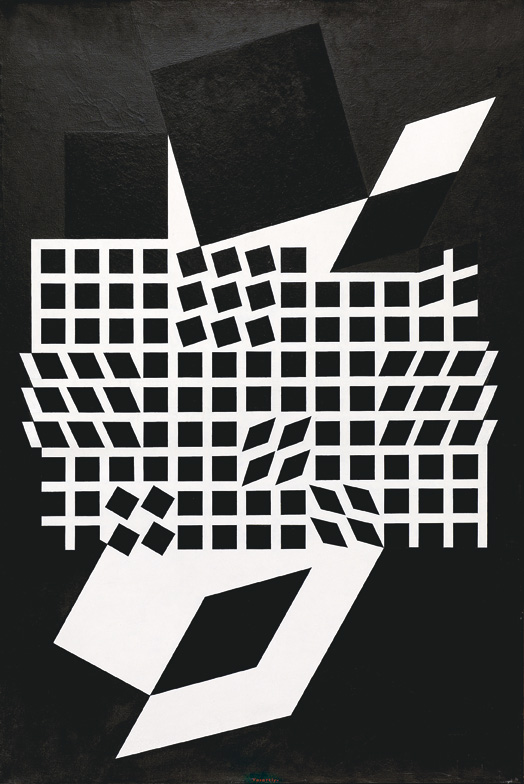Victor Vasarely
OETA, 1956/58
Oil on canvas
195 x 130 cm
© VG Bild-Kunst, Bonn 2022
Photo: Gerhard Sauer
Victor Vasarely’s painting OETA was done during the early days of Op Art, of which he became a leading representative. Influenced by Constructivism and the Bauhaus, Vasarely studied in the late 1920s in Budapest at the Műhely [Workshop], a school for graphic design run along Bauhaus lines. After moving to Paris in 1930, he worked as a commercial artist.
Then in the late 1940s, Vasarely developed a vocabulary of abstract geometrical forms, and in the 1950s he drew inspiration from Josef Albers, who by then was introducing perplexing visual elements into his paintings. The shapes in Albers’s black and white pieces constantly switch between positive and negative, appearing spatial and planar by turn, so that the viewer’s eye is never allowed to come to rest.
The painting OETA is based on a central grid whose squares in some sections are either set on their tips or transformed into rhombi. These groups, consisting of four or nine elements, break up the rigid, regular rectangular form of the grid. They create a sense of motion by pointing in different directions and call on the viewer’s powers of attention, so that his or her eye forever hops from one “disruption” to the next. Above and below the grid, the squares and rhombi assume an independent existence in enlarged form, like the long shadows cast in a nocturnal scene from a noir film. The rhombi resemble here squares represented in space, whose appearance alternates between flatness and the illusion of depth.
In the 1950s, Vasarely adopted the utopian idea of an art that everyone could afford, using mass reproduction and dissemination, and integrating it into everyday life. His art was aimed at having a direct sensual appeal to all, regardless of their level of education. Vasarely’s series of Blancs et Noirs was particularly suited back then for reproduction in newspapers and on television and film. The black and white contrasts visualised moreover the binary system, and Vasarely saw in their “yes and no … works that could be conserved in an electron machine.” (Victor Vasarely, Notes, 1956) (Marjatta Hölz)
Victor Vasarely
1908 born in Pécs (HU)
1997 died in Paris


